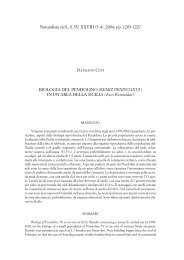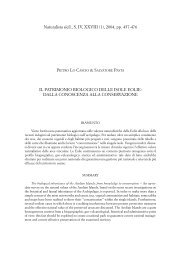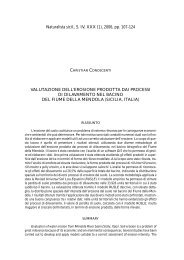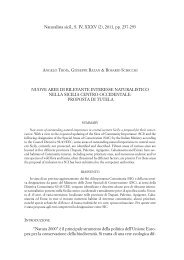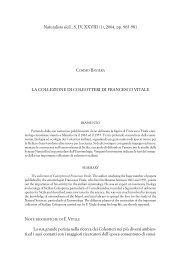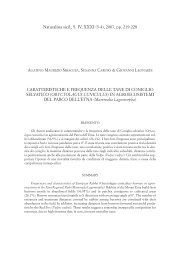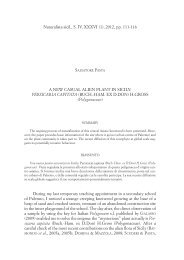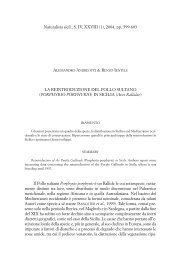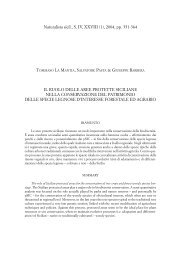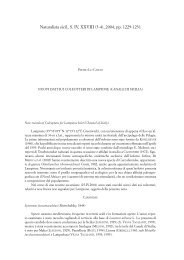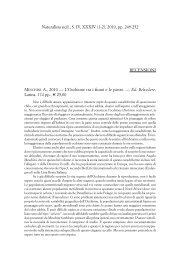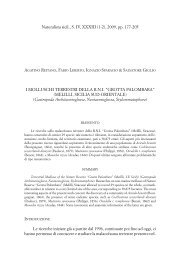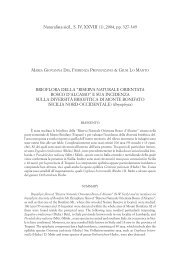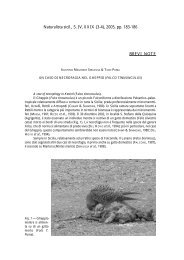2007,pp - Società Siciliana di Scienze Naturali
2007,pp - Società Siciliana di Scienze Naturali
2007,pp - Società Siciliana di Scienze Naturali
Create successful ePaper yourself
Turn your PDF publications into a flip-book with our unique Google optimized e-Paper software.
278 M. SKUHRAVÁ, V. SKUHRAVY´ & B. MASSA<br />
Dasineura oleae (Angelini, 1831)<br />
Corethra oleae Angelini, 1831: 31<br />
Cecidomyia oleae F. Löw, 1885, new synonym (junior homonym)<br />
Syn. Dasyneura lathierei Del Guercio, 1910: in Coutin & Katlabi, 1986<br />
ANGELINI (1831) at first described this species under the name Corethra<br />
Oleae. Galls were <strong>di</strong>scovered at Verona, in northern Italy. COUTIN & KATLABI<br />
(1986) found that D. oleae and D. lathierei are identical species. Larvae cause<br />
slight, indefinite, elongate swellings on the leaves of Olea europaea L.<br />
(Oleaceae) (Pl. VII, Fig. 40). A single larva inhabits a gall where it also pupates.<br />
One or two generations develop a year. Occurrence: DE STEFANI (1906c, 1917)<br />
reported it from Sicily as Perrisia oleae. GIRALDI (1952) mentioned that the<br />
galls of this species in Sicily were found by A. Borzì. DARVAS et al. (2000) evaluated<br />
D. oleae as a pest of olive tree. Distribution: Me<strong>di</strong>terranean.<br />
Dasineura plicatrix (H. Loew, 1850)<br />
Larvae induce galls formed by contorted and twisted young leaves of<br />
Rubus fruticosus L. (Rosaceae) (Pl. VI, Fig. 39). Two or three overla<strong>pp</strong>ing generations<br />
develop a year. Fully developed larvae leave galls, drop to the ground<br />
and pupate in cocoons in the soil. Occurrence: DE STEFANI (1903, 1906c)<br />
found galls of this species in summer along the Bracco river, loc. Zucco<br />
(Palermo); recent records: Castelbuono (Madonie), loc. Vicarietto,<br />
28.7.1999, leg. B. Massa. DARVAS et al. (2000) evaluate this species as a minor<br />
pest. Distribution: European, occurring up to North Africa.<br />
Dasineura pyri (Bouché, 1847)<br />
Larvae develop in curled and rolled leaf margins of Pyrus communis L.<br />
(Rosaceae) (Pl. VI, Fig. 32). Up to 50 larvae may live in one gall. Fully grown larvae<br />
leave galls, fall to the ground and pupate inside a cocoon in the soil. Several<br />
generations may develop per year. Occasionally it may be a serious pest, especially<br />
on young trees (DARVAS et al., 2000). Occurrence: DE STEFANI (1906c)<br />
reported its occurrence in Sicily on Pyrus amygdaliformis Vill. LONGO et al.<br />
(2001) report it from the Etna region. Distribution: European species widely<br />
spread in Europe and introduced into North America and New Zealand.<br />
Dasineura rosae (Bremi, 1847)<br />
Syn. Cecidomyia rosarum Hardy, 1850; Wachtliella rosarum (Hardy, 1850)<br />
Gregarious orange coloured larvae live in pod-like folded leaflets of various<br />
species of the genus Rosa (Rosaceae) (Pl. VI, Fig. 33). Occurrence: DE<br />
STEFANI (1901, 1903, 1906c, 1909) found galls of this species on Rosa sempervirens<br />
L. in the Palermo province, along the Bracco river, in the locality



